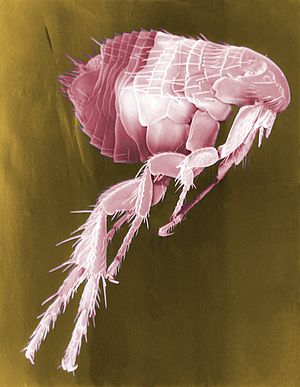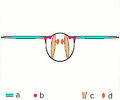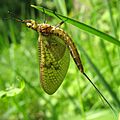Insect facts for kids
Quick facts for kids Insects |
|
|---|---|
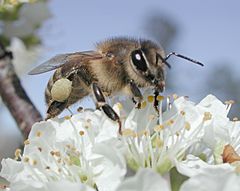 |
|
| A bee on a flower | |
| Scientific classification | |
| Kingdom: | |
| Phylum: | |
| Subphylum: | |
| Class: |
Insecta
Linnaeus, 1758
|
Insects are a type of animal found in the phylum Arthropoda. They are small creatures that live on land. Insects have a hard outer shell called an exoskeleton. They are the biggest group of animals on earth. About 926,400 different species of insects have been found. This means they make up more than half of all known living species. They might even be over 90% of all animal species on Earth!
Scientists are always finding new kinds of insects. Some guess there could be anywhere from 2 million to 30 million insect species in total.
Insects have six legs. Most of them also have wings. Insects were the first animals ever to be able to fly. As insects grow from eggs, they go through big changes called metamorphosis. You can find insects almost everywhere on the planet. Most live on land. Very few insects live in the oceans or in super cold places like Antarctica. The most different kinds of insects live in tropical areas.
Some people call all insects "bugs." But this is not quite right. Only certain insects are true bugs. "True bugs" are a specific group of insects. People who study insects are called entomologists.
Contents
Insect Bodies: What Are They Made Of?
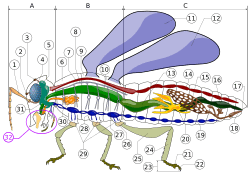
A- Head B- Thorax C- Abdomen
2. ocelli (lower)
3. ocelli (upper)
4. compound eye
5. brain (cerebral ganglia)
6. prothorax
7. dorsal blood vessel
8. tracheal tubes (trunk with spiracle)
9. mesothorax
10. metathorax
11. forewing
12. hindwing
13. mid-gut (stomach)
14. dorsal tube (Heart)
15. ovary
16. hind-gut (intestine, rectum & anus)
17. anus
18. oviduct
19. nerve chord (abdominal ganglia)
20. Malpighian tubes
21. tarsal pads
22. claws
23. tarsus
24. tibia
25. femur
26. trochanter
27. fore-gut (crop, gizzard)
28. thoracic ganglion
29. coxa
30. salivary gland
31. subesophageal ganglion
32. mouthparts
Insects have exoskeletons. This means their skeletons are on the outside of their bodies. Their skeletons are made of thin, hard pieces or plates. These pieces are like armour and are made of a material called chitin. All these pieces together form a hard layer around the insect’s body. This exoskeleton helps protect the insect.
An insect's body has three main parts. These are the head, the thorax, and the abdomen. On the head, you will find an insect’s compound eyes. It also has two antennae, which help it feel and smell things. And, of course, its mouth is on the head.
The thorax is where insects have their wings and legs. All insects have six legs, which are three pairs of jointed legs. Most insects also have four wings, which are two pairs.
The abdomen is the back part of the insect. Inside the abdomen are important organs. These include the stomach, the heart, and the excretory system. This system helps the insect get rid of body wastes. Some insects, like Bees, also have a stinger at the very end of their abdomen.
How Insects Work: Physiology
Just like our muscles connect to our bones to help us move, an insect's muscles connect to its exoskeleton. This allows the insect to walk and move around. Their muscles are on the inside of their skeleton.
Insects are cold-blooded. This means they cannot control their own body temperature. Because of this, insects are not very good at surviving in the cold. In winter, many insects go into a state called diapause. This is like an insect version of hibernation. Some insects, like cockroaches, cannot go into diapause. They will die if it gets too cold outside. This is why cockroaches often like to live in warm houses.
Breathing and Blood Systems
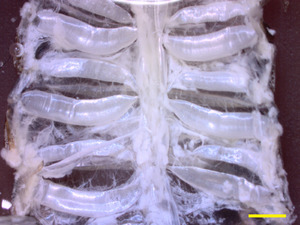
Insects breathe without lungs. They have a system of tubes and sacs inside their bodies. Air moves through these tubes. Air enters through small openings on the sides of their abdomen called spiracles. Oxygen then travels to the tissues that need it through tubes called trachea. Young insects, called larvae, often have gills. These gills can take oxygen from water. Other larvae must come to the water surface to get air.
Adult insects use a lot of oxygen when they fly. Their flight muscles need a huge amount of oxygen. These muscles are some of the most active parts of any animal. Because of how their breathing system works, insects cannot grow larger than about 11 cm long. The biggest insects are about the size of a mouse.
An insect's blood system is different from ours. They do not have veins or arteries. Their 'blood' is called haemolymph. It moves around in a space called the haemocoel. The insect's organs sit in this space and are bathed in the haemolymph. Their 'heart' is just a simple tube that pulses to move the haemolymph.
Insect Life Cycle: How They Grow
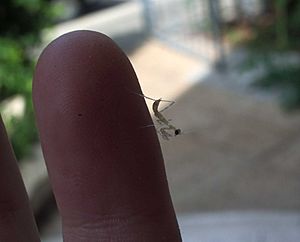
Insects begin their lives as an egg. Usually, a female insect lays eggs. However, a few species give birth to live young. Insect eggs are small, but you can usually see them without a magnifying glass.
After the eggs hatch, insects grow in two main ways. Some insects have 'incomplete metamorphosis'. This means a small insect, called a nymph, hatches from the egg. The nymph looks almost exactly like the adult insect, just much smaller. As the nymph grows, it gets bigger but does not change its shape. It goes through several growth stages called 'instars'. Grasshoppers grow in this way.
Other insects have 'complete metamorphosis'. This means the young insect that hatches from the egg looks very different from the adult. Insects with complete metamorphosis usually hatch as a larva. A larva often looks like a worm. The larva eats a lot and grows bigger. Then, it changes into a pupa. Butterfly pupae are often found inside cocoons. Inside the cocoon, the insect changes its body shape and often grows wings. When the cocoon opens, the adult insect comes out. Many insects, like beetles, butterflies, moths, and flies, have complete metamorphosis. The adult stage is called the imago.
Insect History: How They Evolved
The oldest known insect fossil is called Rhyniognatha. It is about 396 million years old. This ancient insect might have looked a bit like a modern-day silverfish. It already had mouthparts like those of winged insects. This suggests that wings might have developed very early on. So, the first insects probably appeared even earlier, in the Silurian period.
How Wings Appeared
In 2008, scientists found a 300-million-year-old fossil. It was a full-body print of an early flying insect from the Carboniferous period.
We don't know exactly how insect flight started. The first winged insects we know of were already good at flying. Some extinct insects had an extra pair of small wings. This meant they had three pairs of wings in total! It seems insects were not very successful until they developed wings.
During the Upper Carboniferous and Lower Permian periods, some giant dragonfly-like insects lived. Their wings could spread up to 70 cm wide. This made them much bigger than any insect alive today. This huge size might have been because there was more oxygen in the air back then. More oxygen would have helped them breathe better. Also, there were no flying vertebrates (like birds) to compete with them. Many of these early insect groups died out during the Permian–Triassic extinction event. This was the biggest mass extinction in Earth's history, about 252 million years ago.
Different Kinds of Insects
Different kinds of insects are grouped into categories called orders. There are many insect orders. Here are some of the biggest and most well-known insect orders:
- Beetles (order Coleoptera) have their front pair of wings changed into a hard shell. This shell protects their back wings.
- Butterflies and moths (order Lepidoptera) have large, often colorful wings.
- Flies (order Diptera) are special because they only have two wings.
- Ants, bees, and wasps (order Hymenoptera) sometimes have stingers. They often live in large groups called colonies, like ant hills.
- True bugs (order Hemiptera) have a long, thin mouth. It is like a drinking straw and is called a beak.
- Grasshoppers (order Orthoptera) can usually jump very well with their strong legs. They eat grass and grain plants.
- Odonata, which includes dragonflies and damselflies, are top predators of other insects. Both their young (nymphs) and adults eat other insects.
- Phasmatodea, the stick and leaf insects, are masters of camouflage. They blend in perfectly with their surroundings. This group includes the world's longest insect, Chan's megastick.
It is important to remember that Spiders, scorpions, and similar animals are not insects. They are arachnids. Arachnids are arthropods that have four pairs of legs (eight legs in total). Centipedes are also arthropods, but they are not insects either. They belong to a group called Myriapoda.
Insects and People
Some insects are considered pests because they can be harmful to people. Some are parasites, like lice and bed bugs. These parasite insects can sometimes spread diseases. For example, mosquitoes can spread diseases like malaria.
Other pest insects do not directly hurt people. Termites and some beetles eat wood. They can sometimes damage buildings like houses. However, termites also play an important role in nature. They help break down fallen trees and branches on the forest floor. Many insects also eat agricultural products, which are plants grown for people to eat. Grasshoppers are an example of pest insects that eat farm plants.
But many insects are very useful to us! Bees make honey. The larvae of some moths make silk, which people use to make clothing. In some parts of the world, people even eat insects. Eating insects for food is called entomophagy.
Many bees and flies help pollinate plants. This means they help plants make seeds by moving pollen from one flower to another. This is very important for growing many of our foods. Some helpful insects eat pest insects. For example, lady beetles (also called ladybirds or ladybugs) eat aphids, which are tiny plant pests. Many insects also help by eating dead plants and animals, cleaning up the environment.
Insecticides: What Are They?
People often use poisons called insecticides to kill pest insects. But insecticides do not always work perfectly. Sometimes, pest insects become resistant to the insecticides. This means the poisons no longer hurt them. The Colorado potato beetle and the diamondback moth are examples of insects that are resistant to many insecticides.
Insecticides do not only kill pest insects. They can also kill many helpful insects. When helpful insects are killed, like those that eat pest insects, the pest insects might come back in even larger numbers than before. This happens because their natural enemies are no longer around to eat them.
Images for kids
-
Evolution has produced enormous variety in insects. Pictured are some possible shapes of antennae.
-
A pie chart of described eukaryote species, showing just over half of these to be insects
-
The tube-like heart (green) of the mosquito Anopheles gambiae extends horizontally across the body, interlinked with the diamond-shaped wing muscles (also green) and surrounded by pericardial cells (red). Blue depicts cell nuclei.
-
The different forms of the male (top) and female (bottom) tussock moth Orgyia recens is an example of sexual dimorphism in insects.
-
A cathedral mound created by termites (Isoptera).
-
Perhaps one of the most well-known examples of mimicry, the viceroy butterfly (top) appears very similar to the monarch butterfly (bottom).
-
European honey bee carrying pollen in a pollen basket back to the hive
-
Aedes aegypti, a parasite, is the vector of dengue fever and yellow fever
-
Because they help flowering plants to cross-pollinate, some insects are critical to agriculture. This European honey bee is gathering nectar while pollen collects on its body.
-
A robberfly with its prey, a hoverfly. Insectivorous relationships such as these help control insect populations.
-
The common fruit fly Drosophila melanogaster is one of the most widely used organisms in biological research.
See also
 In Spanish: Insectos para niños
In Spanish: Insectos para niños



